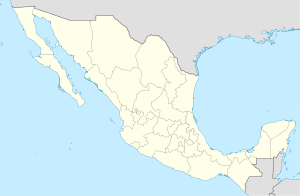Santo Tomás de los Plátanos facts for kids
Quick facts for kids
Santo Tomás de los Plátanos
|
|
|---|---|
|
Town
|
|
| Country | |
| State | Mexico State |
| Municipality | Santo Tomás |
| Elevation | 1,380 m (4,530 ft) |
| Population
(2005)Municipality
|
|
| • Total | 8,888 |
| • Seat | 2,823 |
| Time zone | UTC-6 (Central (US Central)) |
| • Summer (DST) | UTC-5 (Central) |
| Postal code |
51100
|
Santo Tomás de los Plátanos is a town in Mexico. It is also called Nuevo Santo Tomás de los Plátanos. This town is the main place (municipal seat) of the Santo Tomás area. It is located in the western part of Mexico State. The town is about 185 kilometers (115 miles) from Mexico City. It is also 107 kilometers (66 miles) from Toluca.
Contents
About the Town of Santo Tomás
The original name for this area was Caltepec in the Náhuatl language. But by 1631, people started calling the village Santo Tomás. The name "de los Plátanos" was added later by Don Vasco de Quiroga. He added it because there were many banana plantations nearby. This part of the name became official in 1975.
The current town of Santo Tomás de los Plátanos is not the first one. The original town was flooded in 1945. This happened when a hydroelectric dam was built. This dam and its power plant are very important for the region's economy. You can still see the church tower of the old town sticking out of the water!
The current town of Santo Tomás has a nice central garden. It is surrounded by trees and a church. In 2005, about 2,823 people lived in the town.
About the Santo Tomás Municipality
The town of Santo Tomás de los Plátanos is the main governing center. It oversees many smaller communities. Some of these communities are San José Barbechos, La Laguna, and San Pedro el Grande.
The whole area of the municipality is about 110.91 square kilometers (42.82 square miles). In 2005, the total population for the municipality was 8,888 people. The municipality shares borders with Ixtapan del Oro, Valle de Bravo, and Otzoloapan. It also borders the state of Michoacán to the west.
Climate and Nature
The climate in Santo Tomás de los Plátanos is subtropical. This means it is warm, and it has a rainy season in the summer. The area has different types of nature. You can find lowland jungle, temperate forests, and farmland. Sadly, many forests here have been damaged.
Farmers in Santo Tomás de los Plátanos grow many fruits. These include lemons, oranges, papayas, bananas, and mangoes. They also grow coffee, sapodilla, guava, tamarind, and chayotes.
Local Traditions and Economy
From December 18 to 22, the people of Santo Tomás celebrate a special day. It is the feast day of Saint Thomas the Apostle. On October 14, they celebrate the municipality's anniversary. This marks the year 1870 when the municipality was officially formed.
People in Santo Tomás make many crafts. They create stuffed animals, washcloths, tablecloths, and napkins. There are also local bakeries that make bread. However, the main way people earn money here is by raising cattle.
The traditional food in Santo Tomás is turkey mole and tamales. These dishes are often served at family gatherings, weddings, and quinceañeras.
Santo Tomás de los Plátanos offers beautiful views for visitors. It is a great place for activities like rappelling and long walks. There are also special spots for camping and swimming.
Education in Santo Tomás
The main town has 46 schools. These schools are taught by 128 teachers. For the other 24 communities in the municipality, the schools get help from the state and federal governments. These schools teach kindergarten, elementary, and high school. There are 2,081 students in 155 groups, using 97 classrooms.
There is a technical school called "Santiago Santana Avalos." It is located in the Casa de Cultura (House of Culture). In Santa Barbara, students can attend a televised high school. The number of people who cannot read or write is about 18.53%. This is considered a high rate.
Famous People from Santo Tomás
- The welterweight boxing champion of the world, "Pipino" Cuevas, was born in Santo Tomás de los Plátanos. He was born on December 27, 1957.
See also
 In Spanish: Santo Tomás de los Plátanos para niños
In Spanish: Santo Tomás de los Plátanos para niños


